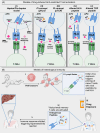The clinical application of genetic testing in DILI, are we there yet?
- PMID: 38872778
- PMCID: PMC11168851
- DOI: 10.1097/CLD.0000000000000218
The clinical application of genetic testing in DILI, are we there yet?
Conflict of interest statement
Matthew S. Krantz reports grants from the National Institutes of Health (T32, HL087738-17). Elizabeth J. Phillips reports grants from the National Institutes of Health (R01HG010863, R01AI152183, and U01AI154659) and from the National Health and Medical Research Council of Australia. She receives royalties from and consults for UpToDate. She consults for Janssen, Verve, Biocryst, Ramboll/Esperion, Lexicomp, Regeneron, AstraZeneca, and Novavax.
Figures

Similar articles
-
Pharmacogenetic testing in idiosyncratic drug-induced liver injury: current role in clinical practice.Liver Int. 2015 Jul;35(7):1801-8. doi: 10.1111/liv.12836. Epub 2015 Apr 20. Liver Int. 2015. PMID: 25809692 Review.
-
Predicting and preventing acute drug-induced liver injury: what's new in 2010?Expert Opin Drug Metab Toxicol. 2010 Sep;6(9):1047-61. doi: 10.1517/17425255.2010.503706. Expert Opin Drug Metab Toxicol. 2010. PMID: 20615079 Review.
-
The application of cytokeratin-18 as a biomarker for drug-induced liver injury.Arch Toxicol. 2021 Nov;95(11):3435-3448. doi: 10.1007/s00204-021-03121-0. Epub 2021 Jul 29. Arch Toxicol. 2021. PMID: 34322741 Free PMC article. Review.
-
[Guidelines for diagnosis and management of drug-induced liver injury caused by anti-tuberculosis drugs (2024 version)].Zhonghua Jie He He Hu Xi Za Zhi. 2024 Nov 12;47(11):1069-1090. doi: 10.3760/cma.j.cn112147-20240614-00338. Zhonghua Jie He He Hu Xi Za Zhi. 2024. PMID: 39497389 Chinese.
-
Genetic risk factors in the development of idiosyncratic drug-induced liver injury.Expert Opin Drug Metab Toxicol. 2021 Feb;17(2):153-169. doi: 10.1080/17425255.2021.1854726. Epub 2020 Dec 14. Expert Opin Drug Metab Toxicol. 2021. PMID: 33222552 Review.
References
-
- Ostapowicz G. Results of a prospective study of acute liver failure at 17 tertiary care centers in the United States. Ann Intern Med. 2002;137:947. - PubMed
-
- Sgro C, Clinard F, Ouazir K, Chanay H, Allard C, Guilleminet C, et al. . Incidence of drug-induced hepatic injuries: A French population-based study: Incidence of drug-induced hepatic injuries: A French population-based study. Hepatology. 2002;36:451–5. - PubMed
Publication types
Grants and funding
LinkOut - more resources
Full Text Sources

